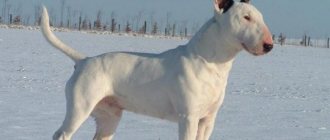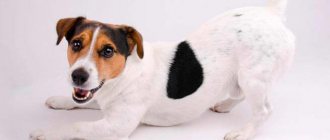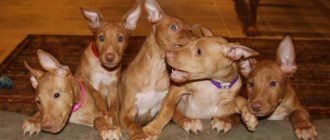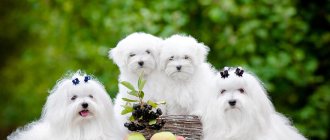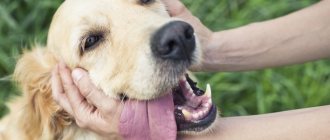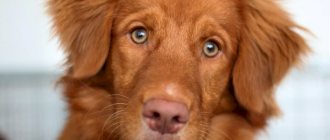We are sure that after reading the words “a dog with a rat face” in the title of our article, many of the owners of these animals will be offended by the author. After all, for them, their beloved four-legged friend is the smartest, most loyal and most beautiful. Perhaps someone sees similarities with the famous rodent - let's not judge them harshly.
Just recently, the domestic media presented the bull terrier as an evil, stupid, aggressive and extremely unattractive creature. At the same time, no one mentioned that sometimes the seemingly harmless Spitz, the cute Dalmatian or the charming Chow Chow are much more aggressive than the Bull Terrier, and that these dogs can be dangerous.
It all depends on the upbringing of the puppy, on what goal a person pursues when purchasing an animal. Some people need a loyal companion, while others want a killer dog next to them. Most often in our time, the latter category of owners includes teenagers who thus want to establish themselves among their peers.
But let’s leave emotions aside and try to figure out what she really is like – “a dog with a rat’s face.” Perhaps, after reading this article, someone will change their opinion about this animal.
History of the breed
The founder of the rat-faced fighting dog was a native of England, James Hinks. The first Bull and Terriers were not particularly attractive. They had a small body on barrel-shaped legs, a short massive head with a blunt muzzle.
As a result of crossing white English terriers with bulldogs and Dalmatians, a new breed appeared in the 50s of the 19th century, a dog with narrow eyes, a long muzzle, and similar in appearance to a pig. She became known as a bull terrier.
A new breed of dog with an elongated muzzle and a shark-like bite was not much reminiscent of bulldogs, the shape of the head changed, and the drooping lips disappeared. The dog with a large, hooked nose became more energetic, while remaining muscular, brave and with good intelligence.
James Hinks achieved his goal; the dog with an elongated muzzle and a crooked pig nose turned out to be graceful, pure white in color.
For reference! The first white bull terrier appeared at a dog show in 1862, and was warmly received by the public.
Thanks to him, the first English bull terrier club was registered in 1887. With the advent of the 20th century, dogs of other colors began to appear. This happened when existing white dogs were crossed with Staffordshire Terriers.
James Hinks with his pet
Body type
Dog with folds: wrinkled pet breed
When examining a dog with a pig's muzzle, what immediately catches your eye is that it has a powerful and muscular body and a rounded chest.
The limbs are muscular and strong. With a massive body, the pit bull pig is very agile and agile. The peculiarity is that the dog has strong jumping ability. The fighting pet constantly runs around due to the large amount of energy.
Bull Terrier Body Type
Description of the breed
Pit bulls with a sharp muzzle are small, but very strong, muscular, fighting dogs. They have an unusual appearance, their muzzle resembles a dog with the face of a rat. And although the breed standard does not provide for restrictions on weight and height, it is believed that bull terriers should reach 45 centimeters in height and weigh 30 kilograms.
The body of a purebred dog is distinguished by strict proportions; it is stocky, dense, and harmoniously developed. The dog should not have a lean or heavy build.
Note! The force with which the dog clenches its jaws is equal to 25 atmospheres; it is impossible to open them with your hands. You can unclench it with a stick or by holding an ammonia solution to the dog’s nose.
Menacing dog with a humped muzzle
Jagdterrier
Nobility and courage are about them.
- Height: 33-40 cm for a male; 28-35 for a female
- Weight: 8-10 kg.
- Lifespan: 13-15 years.
- Color: black, dark brown or grey-tan.
- Coat: medium length, thick. Densely laid over thick undercoat.
Did you know? In 1995, a “dog” record for the length of the swim was set. Labradors Gypsy and Kai, accompanied by their owner, swam 15.2 km (it took 6 hours).
They are easy to train and train, which should be done regularly. Long walks with elements of play (bring a stick or ball) are required, without which the dog will become lethargic or show destructive tendencies.
This terrier will get bored in an apartment, so it is better to keep it while living in your own home. By the way, children will not be the best companions for them (although dogs accept them as “their own”, rushing to help if necessary).
Favorite location is a field where you can chase trophies without restraint, which often ends in a direct fight (brave “yagdas” are not afraid to attack).
Advantages and disadvantages
Bull terriers have long gone from being formidable killers to being companion dogs. The disadvantage of this breed is its excessive stubbornness and desire for leadership. Therefore, not every owner can cope with her upbringing and training.
Only a tough and patient person can deal with this problem. Without proper training, a pupil can become an uncontrollable dog with a lot of problems for others. This is especially true for pets.
In the Bull Terrier, aggression towards animals is inherent at the genetic level. And without proper socialization, a dog can pose a threat to cats and dogs of any breed. In addition, the dog is very jealous of his owner, not wanting to share him with anyone.
Despite these shortcomings, Bull Terriers make excellent companions. Their speed of reaction, physical strength and low pain threshold make them excellent guards. Their devotion knows no bounds.
In addition, you don’t need to have any specific skills in caring for dogs. It is enough to wash and comb them from time to time, get vaccinations and preventive veterinary examinations on time.
Attention! Many people look at such a dog with a rat's face with wariness. For many years, people have been cultivating the idea of their uncontrollable aggression.
Healthy Dog Games
Dogue de Bordeaux
Despite its massiveness and healthy appearance, this is a sickly breed that requires regular preventive examination by a veterinarian. A healthy and caring Dogue de Bordeaux will become a faithful companion and reliable protector.
Curiosity and activity are qualities that are not characteristic of this dog. He almost always behaves with restraint, concentration and calm. There is little that can provoke him into a strong display of emotions.
If a stranger comes into the territory of the Dogue de Bordeaux, he begins to bark loudly, thereby attracting the attention of his owner.
Despite the lack of excessive activity, you should not put your dog on a chain. This will make her unhappy. She really needs to communicate with her owners and loves scratching and other tactile contacts.
The appearance of the animal is unusual. It has thin red fur, drooping cheeks, long floppy ears and a wide mouth. Due to the large number of skin folds on the face, the dog looks sad.
Dogue de Bordeaux is ideal for owners who lead a sedentary lifestyle and prefer to spend most of the day lying on the couch with their beloved pet.
Breed standard
Bull Terriers are self-confident and flexible, their step is light and free, their physique is strong and muscular. Bitches are somewhat more refined than males. The breed standard provides for the following characteristics:
- the head is oval, shaped like an egg, low-set, with a rounded skull and a flat muzzle without changes;
- scissor-shaped jaws with a straight bite, which occurs in sharks, with strong white teeth;
- nose with a large black nose, inclined downward;
- the eyes are small, triangular in shape, oblique, dark brown or black in color;
- ears are small in size, located closer to the back of the head, close to each other, standing vertically;
- the neck is elongated with good muscles, without folds in the skin;
- body with a well-developed, muscular, strong, straight back, compact size;
- the chest is round, wide, the ribs are elastic, rounded;
- limbs are straight, standing parallel to each other;
- medium-sized tail, thickened at the base, narrowed towards the tip;
- the coat fits tightly to the body, the hair is short and hard, and in winter a sparse undercoat appears;
- color from pure white to colored, red, black, brindle, red, tricolor.
In multi-colored dogs, white should not predominate over the rest.
Three friends of different colors
Disqualifying faults
Individuals with blue eyes, born deaf, with overshot or undershot jaws, with nose pigmentation of any color other than black are subject to a ban on participation in the competition and disqualification.
The standard defects include dogs with a convex back, underdeveloped muscles, pronounced cheekbones, and both testicles not descending into the scrotum.
German Shepherd
German Shepherds, bred for working and guarding purposes, are very intelligent and confident dogs. Their long noses and naturally erect ears are classic characteristics of this versatile breed.
German Shepherds, which often become highly trained working and police dogs, require precision and consistency from their owners during the training process.
Character
A dog with a rat's face seems evil only at first glance. In fact, in relation to people, he is the kindest, sociable, devoted, reliable friend, without any hint of aggression. Aggression can be developed in any dog through intentional or poor training.
Bull Terriers are endowed with a sharp mind and high intelligence, with a sound assessment of the situation, with the makings of a wise and fair leader. They are balanced and thinking animals, cheerful, restless, ready to play from morning to evening. Treating their owner with respect and devotion, they demand the same attitude towards themselves.
Good soul dog
Representatives of this breed should not be owned by people who are rarely at home. Bull Terriers need communication, they do not like loneliness. You should not buy a dog as a guard, but they make an excellent nanny for children.
Important! It is worth making sure that a pet that is playing too much does not accidentally harm the baby.
Gampr (Armenian Wolfhound)
This breed is quite large and looks powerful, its height is about 64-68 centimeters, but there are specimens that are about 90 centimeters. The dog's weight varies between 49-64 kilograms, a significant part of it falls on the wool. The muscles are well developed, the body is quite massive, the chest is wide. The ears hang down, the eyes are dark, there are sloping brow ridges, making the look look friendly. The color of this breed varies, most often it is sandy, but the muzzle is always black or gray. The coat is long, the tail does not lie on the back even in a state of excitement.
Gampr is a kind and caring dog, she does not like fuss and clearly follows commands. She usually shows a reverent attitude towards children and remains neutral towards other animals. The dog behaves calmly during training and appreciates encouragement.
to contents ^
Education and training
Bull Terriers, having high intelligence and a desire for leadership, can be difficult to train. This is not a dog for novice dog owners. He needs a strong-willed owner, strict but fair.
The breed requires early socialization and competent training. The pet and its owner must complement each other, then the dog will turn out to be a devoted and reliable friend. An improperly trained dog can manifest its ancient instincts and cause great distress. From a good-natured dog, she can turn into a terrible killer.
Ready for training
Exterior
Compact, small dogs do not exceed 32 cm in height. Since the beginning of the 20th century, griffons have been divided into two weight categories:
- Up to 3 kg;
- 3.5 – 6 kg.
The griffon is shaped like a square. A characteristic feature of the breed is a large head relative to the size of the body and an expressive muzzle. In a “flat-faced” dog, the nostrils are almost at eye level. Widely spaced round eyes are dark in color. The ears are small, cropped and undocked ears are allowed. The tail is usually docked, with the undocked tail carried upward.
See also: American Eskimo Spitz
The elegant Belgian Griffon is a black dog (photo). Color with tan marks is allowed. Griffon dogs' fur is hard, slightly wavy, and tousled; there is undercoat. The hair above the eyes and on the cheekbones is longer and forms the eyebrows, mustache and beard.
Maintenance and care, hygiene
Bull Terriers are not fussy to care for. They molt twice a year. At this time, they are often combed out with a brush or a mitten specially designed for this. Wash pets with animal shampoos as they become dirty, and wipe off dust every day with a damp cloth or sponge moistened with water.
The claws usually wear down on their own during walks. If this does not happen, they are trimmed as they grow. Soured eyes are washed with weak tea or chamomile decoction, and dirt is removed from the ears with a sponge dipped in warm water.
English Setter
This is a large pointing dog originally from England. Bred for hunting waterfowl. The height at the withers is 61-68 cm, weight is not regulated by FCI rules. It has an oval skull and a rectangular deep muzzle, an elegant muscular body, long legs, a tail in the form of a Turkish saber, which is an extension of the back.
The ears are low set, quite long, hang down, forming folds, the top is covered with wool, the tips are velvety. The coat is slightly wavy, long on the chest, belly and tail, the front legs and thighs are decorated with feathering. The color is speckled on a black, orange, yellow or brown background, sometimes with tan. The character is very friendly, lively and energetic.
Features of feeding and diet
It is better to feed bull terriers natural products. Their diet should include raw varieties of lean meat every day, twice a week boiled sea fish without bones, porridge boiled with whole grains, vegetables, fermented milk products, a boiled or raw chicken egg once a week, and vitamin supplements.
In addition, the dog should always have access to clean drinking water, which is changed to fresh water every day.
Attention! Under no circumstances should you feed your dog food from the table.
When choosing industrial feed, be sure to give preference to super premium or holistic brands.
Nutrition
A powerful and muscular dog requires a lot of energy. Therefore, due attention should be paid to creating a daily diet. Recommendations for nutrition are as follows:
- Dry food with a balanced composition is best suited. They contain the proper amount of carbohydrates, microelements and vitamins.
- A strange superstition concerns that a dog should be fed exclusively meat. Experts recommend including 20% cereals and 20% vegetables in your diet.
- Most often, beef and chicken are chosen as the main food. In some cases, it is possible to add sea fish fillets. You can add cottage cheese and sour cream.
The puppy is given his own daily diet. In most cases, it is represented by special food that is rich in useful microelements.
Bull Terrier nutrition
Health and illness
Strange-looking dogs with a pig's face in puppyhood have good health and good stamina. But they are also susceptible to inflammation of the eyes and ears. If they eat the wrong diet, they quickly gain weight and become obese.
They are also susceptible to aortic stenosis, epileptic seizures, joint dysplasia, allergic reactions, and dermatological skin rashes. To maintain their health, timely vaccinations, scheduled visits to veterinarians, as well as active walks and games in the fresh air are necessary.
Additional Information . The Bull Terrier breed does not often have problems with ear infections. But hearing problems regularly arise. Animals with white coat color are especially susceptible to this. Among them there are many puppies born deaf.
White doesn't mean deaf
Hairless dogs
African hairless dog
The African Hairless Dog is one of the oldest dog breeds, originally from Mexico, where they were recognized as a national treasure. You can use your pet to protect your home or as a companion. The main feature of the pet is the absence of hair and delicate skin. Because of this, the dog has a hard time withstanding cold and rain. The hairless dog is distinguished by intelligence, independence and loyalty.
It is important that the breed first appeared more than 3 thousand years ago, as evidenced by mummies and ancient burials in Mexico.
Hairless American Terrier
The American Terrier was bred in America; the pets' ancestors were hunters. But due to the lack of hair, the American Terrier is demanding in climate and is used as an ornamental pet. By temperament - active, passionate, savvy animals, they love to learn new things and follow commands. The animal has no fur, but there may be brown or beige spots on its body.
Chinese Crested Dog
The Chinese Crested is a dog breed originally from Korea, characterized by activity, liveliness, loyalty and sociability. There are suggestions that the breed originated in Africa or Mexico. The peculiarity of the pet is the complete absence of hair, with the exception of the head and tail. The dog's skin color is pink, gray, beige with markings. This breed does not cause allergies and gets along well with other animals.
Manchurian Hairless Dog
The Manchurian Hairless Dog is most often found in the Manchurian region, in the mountains. Local residents call the pet “tai-tai”, but the breed is still not officially recognized by the dog handlers association. The dog also has no hair at all, it has much in common with the Chinese Crested, it does not smell and does not cause allergies. A hairless dog is characterized by loyalty, playfulness and affection for its owner.
Peruvian hairless dog
The Peruvian dog has a medium build, strong paws, and first appeared in Peru many centuries ago. The pet has no fur and is gray and spotted. Also, the Peruvian dog has almost no teeth, but by character they are kind, brave, intelligent animals. They love children very much and can be guards.
By the way, from the Inca language, the name of the Peruvian dog is translated as “Inca orchid”, since the pet is distinguished by grace and stubbornness.
Pharaoh Hound
The Pharaoh Hound belongs to the group of primitive, greyhounds. The breed appeared in Malta, although the first images of pets were found in drawings of Ancient Egypt, in which they personified Anubis. The dog has a small body, slender and muscular legs. The coat is almost absent or very short, the color is red or brown. The Pharaoh Hound is easy to train, loves outdoor games, adores its family and is ready to protect it under any conditions.
Ecuadorian hairless dog
The Ecuadorian dog is considered one of the rarest, it has the least fur compared to other hairless pets. Now you can meet a dog only in some regions of Africa, so there is no exact information about the nature and characteristics of care. They only note that the Ecuadorian Hairless dog is active and energetic, with an average body size.
How to choose a puppy
It's no secret that a purebred bull terrier puppy should be purchased only from trusted breeders or kennels specializing in fighting dogs.
Before choosing a puppy, you need to decide on its gender. Bitches and males are each individual in their own way. If there are more than seven puppies in a litter, they may not have enough mother's milk.
Puppies can be taken from their mother at the age of one and a half months. By this time they should be vaccinated according to age. Puppies should be cheerful, with clean, shiny fur and no signs of skin rashes. The mucous membranes have a pink color, the tail is without creases.
The legs should be the same length, standing parallel to each other. There should be no discharge from the eyes and ears, the ears should be clean, the eyes should be clear, the nose should be shiny and wet.
Note! The appearance of baby bull terriers is very comical, reminiscent of a newborn piglet.
Newborn babies
How much does a bull terrier cost?
The cost of any animal depends on various factors - the presence of a pedigree, the “merits” of the parents, the physical condition of the baby, and its exhibition prospects. Answering the question: “How much does a bull terrier cost?”, it should be noted that the price range today can range from 15 to 70 thousand rubles. The average price for bull terrier puppies in well-known nurseries varies from 30 to 40 thousand rubles. A lower price should alert the buyer.
Interesting Facts
The breed at one time became so popular that teachers and students of the British Oxford University, one of the oldest in the world, considered it an honor to have a white bull terrier.
Of course, all dogs, even of the same breed, are different. But when purchasing a bull terrier, do not forget that this pet needs the firm hand of a self-confident person. A teenager can't handle it. This is a serious dog that requires a lot of time and effort to train, and not just a pet that you can just play with.
Bloodhound
The Bloodhound “sees” the world primarily with its extremely sensitive nose. These dogs are difficult to train because they are constantly distracted by all the smells around them. They also have a ton of energy, stubbornness and determination, and are absolutely unstoppable once they get on the scent trail. It is unlikely that you will be able to force a Bloodhound to do anything against its will. But on a large plot outside the city, where the dog can move freely, your pet will be happy, cheerful and satisfied with life.
Basset Hound
Heavy, low hounds with folded skin and short massive limbs. The length of the body is almost twice the height at the withers.
With a height of 33–38 cm, Basset Hounds weigh 25–30 kg.
The classic color of the English basset combines 2 – 3 shades: white, black, reddish-brown. Long, low-set ears curl slightly inward. Velvety, elastic, thin to the touch.
Basset Hounds were originally kept by hunters on foot. Short, hardy dogs deftly pursued game in thickets of bushes, where it is difficult for medium and large hounds to get through. Nowadays, soft, peace-loving animals are readily adopted for families.
Newfoundland
Once upon a time, these intelligent dogs of gigantic size were fishermen's helpers. They still amaze us with their impeccable working qualities, ability to dive and swim. It is for this reason that Newfoundlands are often used as rescue dogs.
Dogs have a balanced temperament, good nature, ability to learn and a calm disposition. Thanks to these character traits, they make excellent companions, faithful and reliable guards, kind nannies who tenderly adore and protect children.
Separation from loved ones is difficult for them, so you should not leave your Newfoundland alone. By the way, dogs can easily travel and accompany their owner with pleasure.
This is interesting
Also, breeds of rat catchers received the right to exist and spread due to medieval beliefs that a cat is an intermediary of the devil, and it is possible to fight hordes of rats with the help of miniature dogs. Thus, the religious beliefs of Europe posed specific tasks for dog handlers of that time.
Another factor that contributed to the breeding of rat-catching dogs was the craze of people for animal fighting. There were plenty of rats, and keeping a small fighting dog was easy. Although the dogs were not particularly involved in fighting rats, the point was that the dog simply had to strangle all the rats released into the arena, and the audience bet on how quickly he would do this and how many toothy pests he would send to their forefathers.
Ratcatcher dogs were kept on farms, stables, tanneries, granaries, barns, and even taken on ships. A cat strangles mice more for food and games, but for a dog it’s not just a game, it’s prey, it’s excitement. Thus, especially outstanding representatives of the rat catcher breeds could strangle up to 1000 rodents per day. Agree, this is more effective than playing a cat with a mouse.
But the fate of the dog, which serves its owner like a mousetrap on legs, is not as rosy as it might seem. Rats are large and strong enough to fend for themselves, and given the fact that rats live in packs, the dog had a very real chance of getting hurt in a fight. Bitten off pieces of ears, damaged noses and skin, scratched eyes and a chewed off tail - these can be counted among the minor troubles that rats can bring to a dog.
A distinctive feature of all breeds of rat catcher dogs is their light color as a priority. This is due to the need to clearly distinguish a dog from a rat in the dark. Another distinctive feature of rat catchers is that the instinct of self-preservation is minimal, the dogs are strong and courageous, prone to excitement and can rush into battle completely desperately. For the modern owner, the Pied Piper breed is an excellent companion dog option, because loyalty and compactness are an integral feature of the breed group. Another plus is that such breeds get along very well with children and cats, although it is not recommended to have them if you have a hamster, rat, chinchilla or ferret at home for obvious reasons.
Read also (updated 09/24/2020)
Below we have prepared for you links to publications that have recently become particularly popular among our readers:
- how to feed a newborn kitten without a cat;
- why does a cat always want to eat?
- Malamute dog;
- bird robin;
- what a poisonous viper looks like and where it lives.
